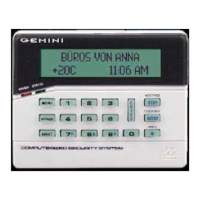
Do you have a question about the NAPCO GEMINI GEM-P1664 and is the answer not in the manual?
| Brand | NAPCO |
|---|---|
| Model | GEMINI GEM-P1664 |
| Category | Control Panel |
| Language | English |
Overview of the GEM-P1664 control panel and supported keypad types.
Provides initial setup steps for GEM-K2AS and GEM-K3DGTL keypads.
Details on how buttons function identically across different keypad types in Program Mode.
Summary of changes made in this manual compared to the previous edition.
Overview of available programming methods: Download, Easy Menu, Direct Address, User Program.
Methods for programming the panel via a computer, including local and remote downloads.
Details on using the menu-driven mode for keypad programming.
Explanation of the flexible direct address programming method.
Information on the user-accessible programming mode for user codes.
Key information about the Dealer Program Mode, including default code.
Step-by-step guide to enter the Dealer Program Mode from the keypad.
Procedure for creating a custom default program for new panels.
Configuring the total number of zones, panel zone doubling, and fire zones.
Setting up 2-wire fire zones and local/central station reporting.
Defining zones to be used as Exit/Entry zones.
Configuring Interior, 24-Hour, and Chime zones.
Setting up Exit/Entry2, 50mS loop response, and AUX output zones.
Configuring Sensor Watch and Keypad Sounder zones.
Enabling Auto Bypass Re-entry and No EOLR zones.
Configuring Telco Line Fault Test and Burg Output Chirp on Key Fob.
Enabling SIA CP-01 and setting the number of keypads.
Entering the telephone number for Central Station Receiver 1.
Configuring account number and format for CS Receiver 1.
Entering and configuring user codes and their area options.
Detailed explanation of user code and area option data entries.
Mapping RF transmitter points and using the quick enroll method.
Assigning key fobs as zone inputs or arm/disarm devices.
Entering zone descriptions and the dealer code.
Steps to exit the Dealer Program Mode and return to normal operation.
Procedures for clearing the dealer program or performing a cold start.
Configuring total zones, panel doubling, and fire zones for these keypads.
Setting up 2-wire fire zones and local/central station reporting.
Defining zones to be used as Exit/Entry zones.
Configuring Interior, 24-Hour, and Chime zones.
Setting up Chime 2, Exit/Entry2, and 50mS loop response zones.
Configuring AUX Output and Sensor Watch zones.
Configuring Sensor Watch and Keypad Sounder zones.
Enabling Auto Bypass Re-entry and No EOLR zones.
Configuring Telco Line Fault Test and Burg Output Chirp.
Enabling SIA CP-01 features for false alarm reduction.
Configuring keypad settings and CS Receiver 1 details.
Setting the account number and format for CS Receiver 1.
Entering and configuring user codes and their area options.
Detailed explanation of user code and area option data entries.
Mapping RF transmitter points and using the quick enroll method.
Assigning key fobs as zone inputs or arm/disarm devices.
Limitations on entering zone descriptions, date, and time.
Procedure for entering and verifying the dealer code.
Explanation of the direct address programming method's flexibility.
Steps to enter Direct Address Program Mode from Dealer Program Mode.
Understanding the display format for address and data entry.
Keypad commands for navigating and entering data in Direct Address Mode.
Walkthrough of programming zones using Direct Address Mode.
Steps to determine and enter data values for specific addresses.
Explanation of symbols and conventions used throughout the manual.
General steps for programming using addresses and data values.
Configuring exit/entry delays and timeouts for system operation.
Setting chime timeouts and AC fail report delay options.
Configuring timeouts for PGM and Alarm outputs.
Settings for panel download/callback and pager format.
Configuring system responses to global events and troubles.
Setting system responses for Area 1 and Area 2 events.
Configuring the global ambush code for silent alarms.
Setting system responses for Area 3 events.
Setting system responses for Area 4 events.
Configuration options for addresses 1420 and 1421.
Configuration options for addresses 1422 and 1423.
Configuration options for address 1424.
Configuration options for addresses 2051 and 2052.
Configuration options for addresses 2053 and 2054.
Configuring formats and Telco options for CS receivers.
Entering telephone numbers for Central Station receivers.
Setting subscriber opening/closing and event IDs for Telco 1.
Setting subscriber opening/closing and event IDs for Telco 2.
Setting subscriber opening/closing and event IDs for Telco 3.
Configuring reporting codes for CS system events.
Setting reporting options for specific areas and the system.
Configuring zone reporting codes for control panel and EZM zones.
Configuring user opening and Telco 1 reporting options.
Configuring user opening and Telco 3 reporting options.
Configuring EZM group options for zone expansion modules.
Setting priority arming options for different areas.
Configuring burglary output silencing when disarming.
Selecting areas where burglary output can be silenced upon disarm.
Configuring pulsed burglary output silencing when disarming.
Selecting areas where pulsed burglary output can be silenced upon disarm.
Configuring PGM1 output silencing when disarming.
Selecting areas where PGM1 output can be silenced upon disarm.
Configuring PGM2 output silencing when disarming.
Selecting areas where PGM2 output can be silenced upon disarm.
Configuring keypad type and assigning unique addresses.
Setting various options for keypad functionality.
Setting temperature limits and enabling display for Zone 6 sensor.
Enabling the temperature display feature on compatible keypads.
General zone options and reporting configurations for zones 1-16.
Configuring external relay events, including area, timeout, and condition.
Step-by-step guide for programming relay events.
Tables detailing relay numbers, areas, and related options.
Tables for configuring timeout, event ID, and activation conditions.
Selecting the number and type of RF receivers.
Setting supervisory timers for RF transmitters.
Procedure to erase the dealer program for a fresh start.
Procedure to erase all programs, returning the panel to factory defaults.
Steps to enter the User Program Mode for code management.
Instructions for programming user codes on GEM-K2AS keypad.
Instructions for programming user codes on GEM-K3DGTL keypad.
Instructions for programming user codes on GEM-K4RF keypad.
Requirements for installing and assigning addresses to keypads.
Using jumpers to configure keypad features like backlight and sounder.
Diagram illustrating system wiring and important installation notes.

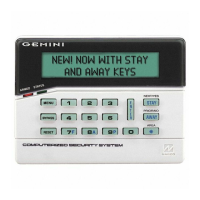





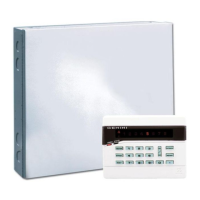
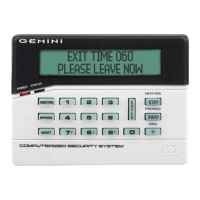
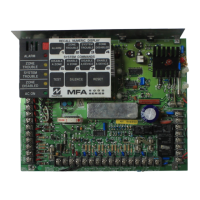


